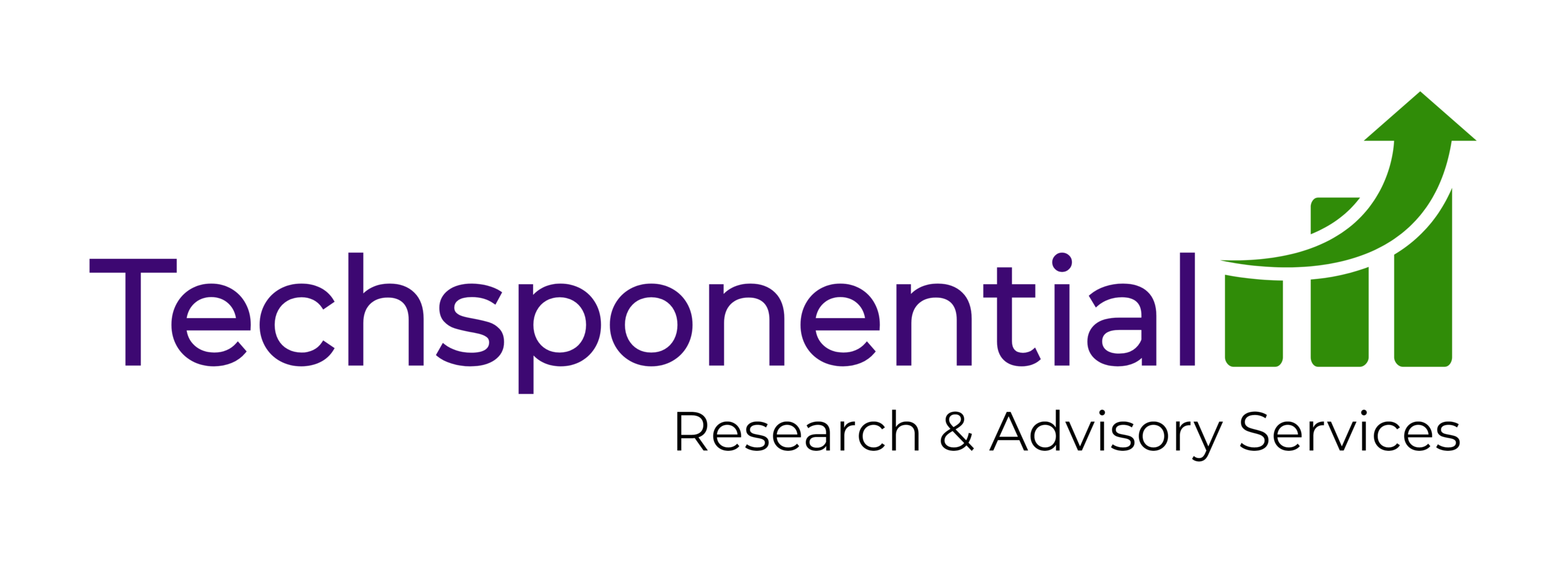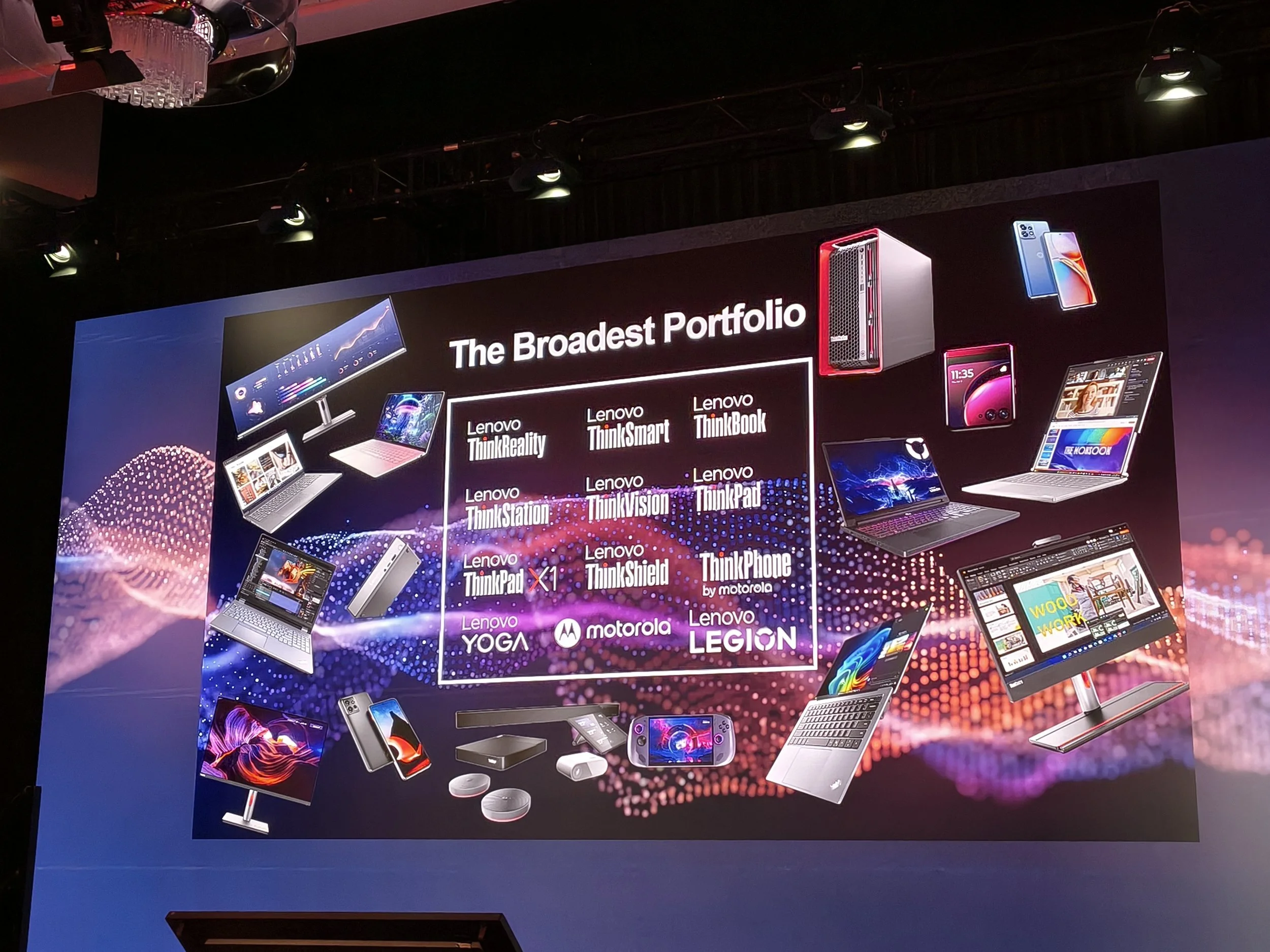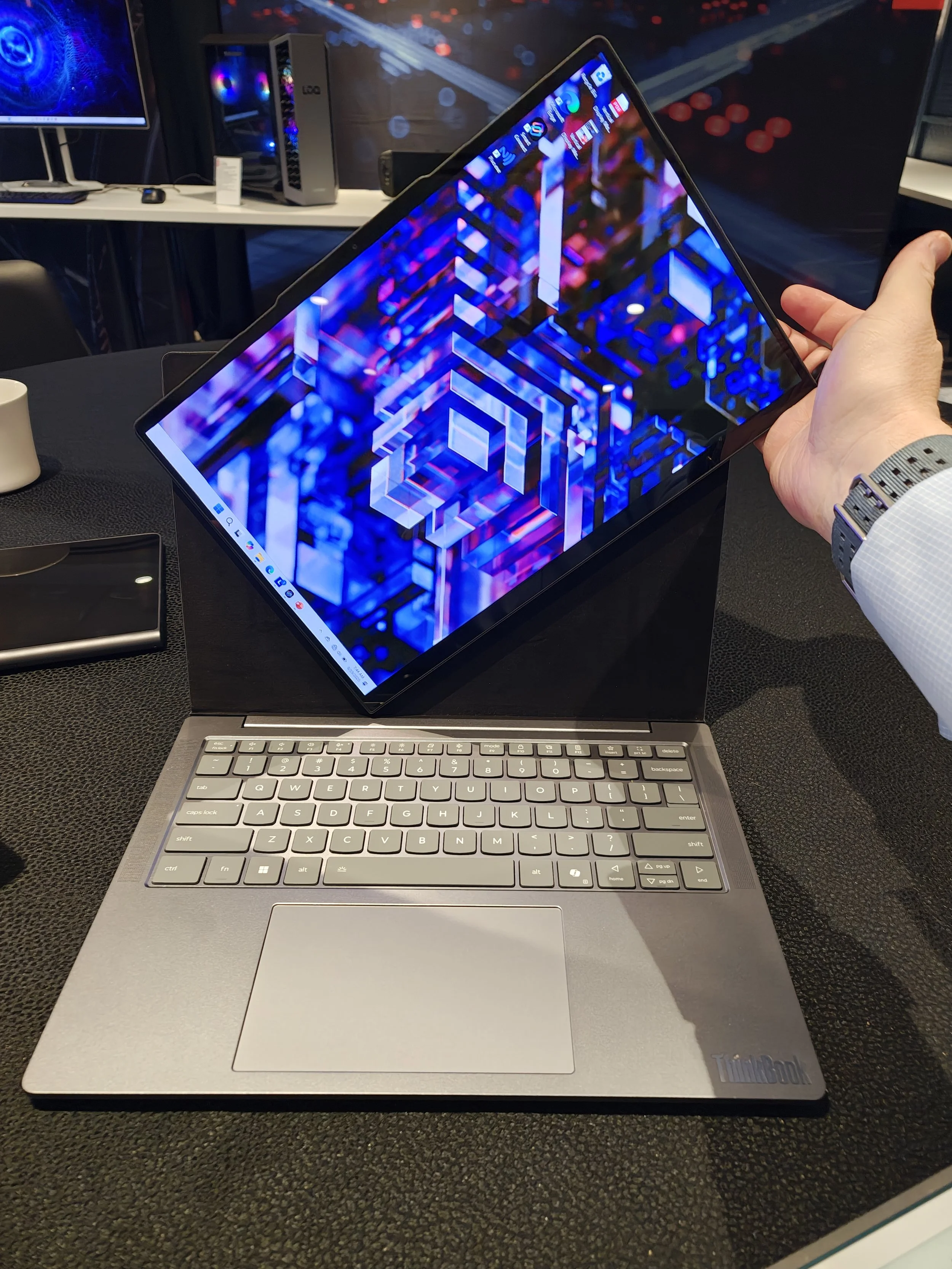IFA 2025: Lenovo Innovation World Showcases Product Breadth and R&D
Summary
Lenovo is the world’s largest PC vendor with nearly 25% market share, and it owns Motorola Mobility, where revenue is up 14% year over year. At Lenovo Innovation World at IFA 2025, Lenovo showed off just how extensive its capabilities are across different products and markets. The company had something for absolutely everyone in Berlin: workstation laptops, productivity laptops and tablets, monitors, docking stations, gaming laptops and handhelds, smartphones, and R&D concept devices – one that may never reach the market, and one that absolutely should. Lenovo’s breath of products can also be seen in the fact that every major silicon vendor was represented, with products using Intel, AMD, NVIDIA, Qualcomm, and MediaTek chipsets.
Lenovo’s PC and Motorola Phone Divisions Are Starting to Coordinate
One key change from past events was the integration of Motorola announcements alongside Lenovo’s PC and handheld gaming products. Apple benefits greatly from people buying into its hardware ecosystem across phones, tablets, and Macs. Samsung makes all three categories as well but has never fully leaned into its PC division. Lenovo previously had operated Motorola completely separately from its PCs and tablets, but the flight from Chicago (Motorola HQ) to Research Triangle (Lenovo HQ) just isn’t that long. It was encouraging to see new Moto products launching alongside YOGA and Legion, and the promise that the marketing coordination is being followed by software engineering and AI. At the show, Motorola announced two new phones:
Moto Edge 60 neo – this lower-priced version of Moto’s Edge 60 Pro flagship will be getting a release in the U.S. as well as the “Moto Edge 2025.” Verizon has already reached out noting that in the U.S.)
Moto G 06 POWER – a new entry in Moto’s long-running POWER variant of the G series, only now it sports a positively huge a 7000 mAh battery, a 6.88" display, and Google Circle to Search at a budget price. While Motorola has been selling a lot of razrs in the US and Edges everywhere else, the Moto G is still the volume handset, particularly in LatAm.
At the hands-on area at Lenovo Innovation World after the press conference, Lenovo also had a nice display of the razr Swarovski special edition and matching Buds earbuds.
Hands On With the Rest of Moto’s New Phones
These announcements came on top of other recent launches, including the Moto g 06, new razrs, razr+, razr ultra, and Moto Edge 60 pro. I have been testing nearly all of them; the razr remains the best small foldable for use when closed at both ends of the price spectrum. The base razr 2025 sports a MediaTek chipset that sets no performance records but is perfectly fine for a foldable that retails for as little as $400 at U.S. prepaid carriers. The new razr ultra manages to get nearly full flagship benchmarks from Qualcomm’s Snapdragon 8 Elite despite the folding form factor – outperforming Samsung’s Galaxy Z Flip7 which relies on an Exynos 2500. The Moto Edge 60 Pro is Moto’s flagship bar phone; it is not available in the U.S., so Berlin was an ideal testing ground for my reviw unit. The Edge 60 Pro offers the best camera performance from the brand yet, though the phone is closer to a base model from competitors than “Pro” both in capabilities and price. Unlike competitors, colors and materials are a key area for Motorola across the price spectrum: my Moto G and Moto Edge 60 Pro are both bright blue, while my razr is pink and razr ultra has a real wood rear panel. I’m a fan; when consumers move up the price and performance ladder they don’t automatically want their phones to be boring. Motorola does offer monochromatic options, too, but the colors are starting to sell better.
Better Marketing Out of Lenovo, Too
Lenovo is an F1 sponsor, so you might expect a driver or team manager to appear on stage, but instead Lenovo brought F1’s …IT manager? Lenovo’s F1 partnership is not just a branding deal, and we heard about how F1 uses Lenovo technology for race management, back office business management, and sustainability goals. Well done. Lenovo also provided customer testimonials from Dreamworks, which uses Lenovo desktops, workstations, and servers. The pitch was not subtle: "We don't generate images with AI. We have the best artists in the world for that. But we can support them with AI." "Also, please see Bad Guys 2."
Enterprise Products and Variations
ThinkPad X9 Aura Edition in White – the ThinkPad X9 Aura Edition was introduced at CES earlier this year, and a new white colorway was announced at IFA. This is Lenovo’s bid to appeal to those seeking a more Mac-like, balanced design. As such, it drops the red TrackPoint pointing nub and consolidates cooling and ports in a ridge running across the bottom. I have been testing the boring black version; it's an excellent all-around laptop, but since it is part of the ThinkPad line and sold primarily to enterprise customers, it can’t really compete against the MacBook Air directly with consumers. That’s especially a shame for the white version; while Apple has injected chromatic variety into the iPhone 17 Pro line, the Mac remains shades of silver and black.
ThinkPad laptop workstations – Lenovo has a trio of heavy duty workstation laptops: the ThinkPad P1 Gen 8 16” powerhouse featuring up to Intel Core Ultra 9 Series 2 vPro processors, an integrated NPU, and NVIDIA RTX PRO. Flanking it are the lighter weight ThinkPad P14s i Gen 6 (14”) and ThinkPad P16s iGen 4 (16”).
Small form factor AI – NVIDIA’s DIGITS is not the only small form factor desktop aimed at AI developers. Lenovo announced the ThinkCentre neo Ultra Gen 2, an Intel-based tiny desktop though the GPUs on offer are still from NVIDIA. Fully kitted out, the ThinkCentre neo Ultra Gen 2 offers XPU up to 825 TOPS and supports 14B LLM localization.
Docking stations – Lenovo expects enterprise buyers to pair one of the new workstations with an equally capable ThinkPad Thunderbolt 5 Smart Dock 7500. Lenovo also had two other lesser docks to show off: the ThinkPad Thunderbolt 4 Smart Dock Gen 2 7500, and the simpler ThinkPad USB4 Smart Dock 5500.
Hybrid Work Monitor – while the ThinkVision P40WD-40 may look like a huge, curved gaming monitor, Lenovo is billing its 24-120Hz variable refresh rate as an energy saving feature. The 39.7” display has both extremely high 5K resolution (5120x2160) and high color accuracy (98% DCI-P3 and 99% sRGB). There is a built-in single-connection Thunderbolt 4 dock for quick connection. I do not have this monitor yet. I want one.
Consumer and Gaming
Tablets – Lenovo is pushing its Android tablets into premium laptop-replacement territory with a new YOGA Tab featuring a Qualcomm Snapdragon 8 Gen 3, an 11.1" 3.2K PureSight Pro display, and an included Tab Pen Pro and 2-in-1 keyboard. For those on a tighter budget, the Lenovo Idea Tab Plus has a MediaTek Dimensity 6400 and an 800 nit 12.1” 2560x1600 display. The Tab Pen and keyboard covers are optional.
Gaming – While it had been teased before, we now have details on Lenovo’s next generation Legion Go portable gaming handheld with AMD’s Ryzen Z2 Extreme. It’s expensive, but everything in this class is. I look forward to getting in a review unit at launch later this year. If you’re looking for Legion-branded display glasses to use with your handheld, the Legion Glasses 2 now support 3D content via an software updated.
Lenovo announced a new entry in its budget gaming LOQ line, the Lenovo LOQ Tower 26ADR10 (AMD), which is powered by AMD Ryzen 8000 series processors and NVIDIA GeForce RTX GPUs.
Lenovo has plenty of new displays to go with it, though some of these are more likely to be paired with higher end systems. The Legion Pro 32UD-10 and 27UD-10 are 4K displays in 31.5" and 26.5" sizes, respectively, with 240Hz refresh rate and 0.03ms response time, plus 99% DCI-P3 and sRGB color accuracy in case you want to use them for photo editing on the side. The Legion Pro 27Q-10 is a slightly lower resolution (1440p) 26.5” widescreen OLED gaming monitor with a 280Hz refresh rate and a 0.03ms response time. That’s an impressive combination for FPS games.
Concept Devices
Lenovo has been opening up its R&D labs and showing off concept devices its engineers have dreamed up. Some of these devices have made it to market. Last year’s rollable laptop concept is now a limited release ThinkBook Plus Gen 6 Rollable, and I brought it to Germany with me and then on to Apple’s iPhone launch the following week. It’s terrific! It’s expensive, but the expanding display is not a gimmick – if you can afford it, it’s worth buying. Lenovo needs to rename this the Lenovo Expand, focus on halo retail and online channels – maybe a Costco treasure hunt item? – and promote it heavily. Luxury tech is a real category. There’s no point in building unique products, actually productizing them, and then burying them with unrecognizable names, no distribution, and no marketing.
However, the Lenovo Expand (that’s my name and I’m sticking with it) is quite expensive. So Lenovo is following it up with a superb product concept with yet another terrible name: the ThinkBook VertiFlex Concept. This is a regular clamshell laptop with a regular display, only the screen is on a hinge so that you can manually flip it into portrait mode. I got some time with one back in New York. For the cost of a hinge you get tremendous flexibility. I am officially renaming this the Lenovo Rotate and implore Lenovo to bring this to market with its new name quickly.
Lenovo also showed off the Lenovo Smart Motion Concept, a motorized laptop stand that can rotate and rise automatically, while the base offers built-in cooling to the laptop sitting on it. I'm less convinced about the market opportunity for this one, but “Smart Motion Stand” isn’t a terrible name and it would be great for accessibility.
For Techsponential clients, a report is a springboard to personalized discussions and strategic advice. To discuss the implications of this report on your business, product, or investment strategies, contact Techsponential at avi@techsponential.com.





















